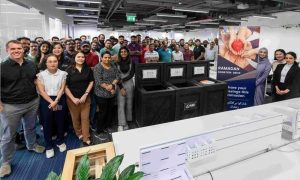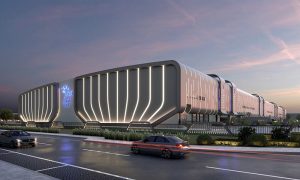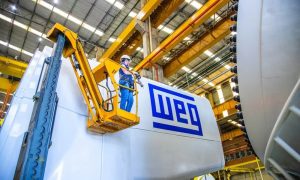Workplace diversity
Maximising and capitalising on workplace diversity

Profit and non-profit organisations need diversity to become more creative and open to change. Maximising and capitalising on workplace diversity has become an important issue for management in this region, says Fahad Abdullah Al Ameri, Head, Human Resources & Public Relations, Al-Qahtani Pipe Coating Industries.
The world’s increasing globalisation requires more interaction among people from diverse cultures, beliefs, and backgrounds than ever before. People no longer live and work in an insular marketplace; they are now part of a worldwide economy with competition coming from nearly every continent.
The challenge of creating a multicultural, diverse organisation is becoming an increasingly prominent concern for the chief executive officers (CEOs) of companies in the world. Diversity management initiatives are long-term and strategic in focus; they strive not only to recruit but to actively develop, promote, and capitalise on the different skills and perspectives of minority employees, and involve fundamental organisational change.
Cox (2001) suggests that “multicultural organisations” are the most flexible firms; actively integrating minorities into the company structure and building an appreciation among employees for individual differences. These types of firms tend to consider diversity in an inclusive manner that encourages unity. Still, diversity in numbers alone (surface diversity) will not be likely to contribute to workplace harmony. Diversity must be accepted and integrated into the firm’s social and business fabric.
Research by Brock and Sanchez (1996) supports the hypothesis that a diverse environment can increase worker satisfaction only as long as real or perceived discrimination does not exist. But by making diversity a priority and increasing the acceptance of differences within the organisation, they suggest, firms can increase the commitment of minority employees, which can contribute positively to minority retention and personnel development. This is the heart and essence of this investigation.
Gulf countries which have a wide spread of industries and primarily oil refinery and production have been a hub of employment for many people. It cannot be denied that domestic labours of these countries are not sufficient to answer to the diverse manpower needs of available employment.
Expatriations have slowly diffused to the Middle East searching for better opportunities. In a survey carried out from 1995 to 2007, Gulf countries were recorded as nations that required the most number of workers from around the world. In fact, this phenomenon had helped many third world countries to provide working opportunities to its citizens and have provided higher revenues to their countries.
Saudi Arabia, as one of the leading countries in this region, had also faced the consequences of employing a diverse range of people to answer the labour call. Reports state that 80% of its labour forces across all industries are now foreign nationals. Many companies are spending huge amounts to provide entry and working visas in order to entice workers. Manpower requirements range from technical to mechanical and including labourers recruited from different countries, based on their expertise and specialisation.
With the advent of technology and with the demand of its client, companies have diversified their business nature and orientation, venturing into white and blue collar jobs, which allowed it to employ different people of different skills, expertise and specialisation, in order to attend to clients’ requirements in the most efficient way. To this effect, diversity of workforces and exist in these niches – and with it a multi-faceted and strong management structure is therefore necessary to hold, retain and motivate employees.
The challenge
It can be clearly understood that diversity management is faced with the dilemmas on four different aspects namely: leadership traits, peer relationship, behaviour and selection practices.
Leadership traits of middle managers are a key factor to the success of any company, as it inevitably directs activities. A leader who does not possess the key elements of good leadership may pass down poor directives, which can result in mismanagement and staff becoming jeopardised. Prudent decision-making is one trait that should emanate from a leader – poor decision making processes put all those who are involved in the organisation on a danger.
In a larger context, employees’ behaviour is a result of how management handle the work. Good or acceptable behaviour among employees emanates from solid leadership, and with this allegiance tends to follow with time. A “pro-people” approach rather than a “system orientated” approach will also ensure that relationships between management and employees are solidified.
In a diversified culture, various nationalities are working side-by-side, and in spite of many misunderstanding s and ignorant preconceptions which may appear from time-to-time. Differences in religion, language, beliefs and practices are always present and it is the sign of a strong leader who can forge these differences and synchronise employees under one common goal.
It is best therefore to consider that selection practices be given attention to alleviate problems in the future. Human resource management may find it necessary to set higher standards of criteria and qualifications to hire and employ diversified employees who are flexible and adoptable in an unstable environment to “fit in” the best employee in a suitable work environment.
The solution
It’s inherent for a business to solve and improve the existing environment, especially when attaining its objectives is sacrificed. A wide array of possibilities for intervention will help to build a trust and a healthy work environment and convenient organisational structure.
A seemingly weak workforce diversity management programme must initiate a move to orient the upper management on diversity goals and encourage board attendance at any organisational diversity events. This could be realised by encouraging diverse board leadership (chair, other officers, and committee heads) and help find ways and means to engage the managers or supervisors and employees in diversity training or conferences. We have to remember that the world of work is fast changing and so keeping ourselves abreast with these changes will help them all put things in order.
In the same way, it is best to create a committee that will map out an action plan for ascension in the organisation of high performing or high potential minorities. These can include, but are not exclusive to: discussion of their career interests, the skills and experiences they need to progress in the organisation and how they will obtain those skills and experiences; who is mentoring them; and what internal or external contacts they need for building relationships.
Fahad Abdullah Al Ameri, Head, Human Resources & Public Relations, Al-Qahtani Pipe Coating Industries
Further to this is the creation of a team of senior managers inclusive of all lines of business and staff functions that assists in the development of plans to address obstacles and barriers affecting diversity management.
In as much as communication bridges the gap between the high and the low profile in any work environment, an open communication should be well established from and among the employees, middle managers and higher management to thresh out problems related to relationship, behaviour, leadership, motivation, advancements, social and emotional dilemmas to discover strength and weaknesses of the people. This can be facilitated by the human resource office through a well-established, balanced and unprejudiced programme, addressing the needs of the people regardless of their culture, background and ethnicity.
Cultural diversity training programs must also be set for all the employees and managers or supervisors concerned. This training will help them be aware of the different cultures and beliefs for a diverse workforce existing in company. In a like manner, a seminar or workshop on team building should be frequently conducted and implemented for cohesiveness and unity amidst the diversity of the work.
Fahad Abdullah Al Ameri
- Fahad Abdullah Al Ameri is currently Head, Human Resources & Public Relations, Al-Qahtani Pipe Coating Industries. He is also presently in charge of Public Relations & Media for Abdel Hadi Abdullah Al Qahatni & Sons Group of Companies, where he develops, coordinates, and directs public relations activities.
Before this position, he held a position as a teacher in the Ministry of Education, as well as with the Ministry of Post & Telecom in KSA.
He has also held various managerial positions for operations involving pre-openings of various hotels in the region, including the FAMA Holding Group (Sunset Beach Resort) and Al-Khobar Holiday Inn.
Fahad has a Bachelor Degree in Education Programme from the University of Bahrain and an MBA from AMA International University (Bahrain), which specialised in Human Resource Management.
Fahad can be contacted at diversity@windowslive.com
















